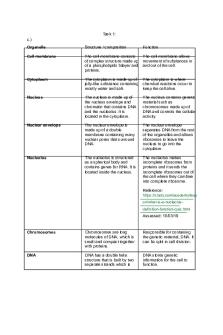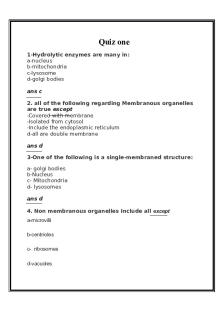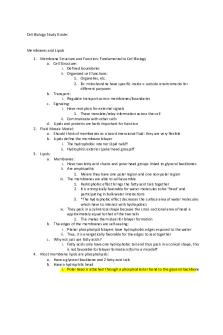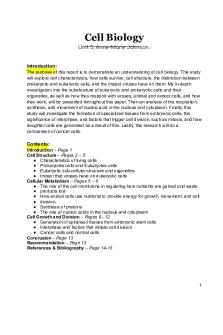CELL Biology EXAM 1 Outline-1 PDF

| Title | CELL Biology EXAM 1 Outline-1 |
|---|---|
| Course | Cell Biology |
| Institution | University of Louisiana at Monroe |
| Pages | 23 |
| File Size | 798.4 KB |
| File Type | |
| Total Downloads | 49 |
| Total Views | 153 |
Summary
lol...
Description
CELL BIOLOGY- EXAM 1 I.
What is a cell? A. B.
The smallest and fundamental unit of life Each cell has 3 things in common 1. 2. 3.
C.
Two types of cell: 1. 2.
II.
Prokaryotic Cells Eukaryotic Cells
Prokaryotic cells A. B. C. D. E.
Much smaller than a eukaryotic cell Can be many different shapes Can have an external cell wall outside of the plasma membrane Have a simple internal structure with no membranes Due to simple internal structure, division is very rapid 1.
F. G.
III.
Plasma membrane- the boundary between the cell and environment Genetic information- location may differ, but every cell has it! The ability to produce proteins using genetic information DNA is used to make a copy of RNA, RNA is used to make a protein
Binary Fission- division usually takes about 20 minutes
Evolution can occur quickly Have many habitats and food sources
Eukaryotic cells A. B. C.
Much larger and more complex than prokaryotic cells Can be single or multi-cellular Contains many organelles and protein components 1.
2.
Nucleus Surrounded by a nuclear envelope Contains DNA molecules Double membrane Materials enter and exit through pores in nucleus Mitochondria Double membrane Generators of chemical energy for the cell; they harness the energy from the oxidation of food molecules to produce ATP Contain their own DNA Reproduce by dividing in two
3.
4.
5.
6.
7.
8.
9. 10.
Chloroplasts Found only in PLANT cells Double membrane Undergoes photosynthesis to produce sugar Contains chlorophyll which absorbs light Contain their own DNA Reproduce by dividing in two Endoplasmic Reticulum The site that manufactures most cell-membrane components and materials that are destined for export from the cell Double Membrane Smooth ER o Membrane channels that produce LIPIDS o Does not contain ribosomes Rough ER o Involved in the synthesis of secreted and membranebound proteins o Studded with ribosomes Golgi apparatus/complex Receives materials made by the ER, modifes them, then redirects them Can be multiple in a cell depending on the type of cell SINGLE MEMBRANE Lysosome Small, irregularly shaped sacs that digest and break down molecules Recycles and releases wanted material back to the cell Single- membrane Peroxisome Membrane- enclosed vesicles in which oxidative reactions occur Hydrogen peroxide is broken down to break down lipids and destroy toxic molecules Endosome An incoming package The early entrance stage of endocytosis Similar to vesicles Can mature and become a lysosome Cytosol Water- based gel in which organelles reside Cytoskeleton A system of tubular-shaped protein flaments that provide the cell with structure and strength
3 types of flaments: actin filaments intermediate filaments microtubules not truly a membranous organelle Vesicles Used for storage and to transport material 2 types of vesicles: transport vesicles- transports material from one organelle to another secretory vesicles- vesicles destined to go OUTSIDE of the cell
11.
D.
Dynamic Cell 1.
IV.
There are millions of processes going on in a cell at the same time
Endomembrane System Importance A. A subset of organelles in a eukaryotic cell that work together to modify, package, and transport lipids and proteins throughout the cell 1. Every membrane is ultimately the same (composed of phospholipids) which allow fusion events to occur by means of vesicles
B.
Production and transport of proteins 1.
2.
3. 4.
Nucleus Porous double-membrane organelle Outer membrane is connected to the ER Ribosome RNA travels from the nucleus to the ribosome where protein synthesis occurs Ribosomes can be free or attached depending on the signal Free ribosomes are located in the cytoplasm and produce proteins that are used by the cell Attached ribosomes are located on the cytosolic surface of the ER and produce proteins into the lumen of the ER and are transported out of the cell Golgi Vesicles produced in the ER transport proteins to the golgi body Golgi structure There are 2 sides to the golgi body: cis and trans cis side is closest to the ER trans side is closest to the plasma membrane vesicles from the ER are accepted/fused to the cis side, and will leave from the trans side
5.
6.
V.
every package goes in the cis side, translocates down the frst lumen, buds off, and goes through the next until it reaches the trans side transport can only occur because of vesicles and can only be used because the vesicle fuses to another membrane
Exocytosis Materials that are destined for use outside of the cell are released by exocytosis Secretion 2 types: regulated and constitutive regulated- must be turned on constitutive- always happening
The Chemistry Behind Life A. Based on carbon compounds B. Require aqueous environments C. Very complex; has several subunits that make up polymeric molecules D. Tightly regulated because a cell needs to be able to regulate when chemical reactions occur
VI.
Atom A. An atom is the smallest particle of an element that retains the characteristics of that element 1. 2. 3.
B.
Atomic number 1.
C.
The number of protons in the nucleus of an atom
Atomic weight 1.
D.
Protons = positive charge; located in the nucleus Neutrons = neutral; located in the nucleus Electrons = negative charge; located in orbitals/shells around the nucleus
The number of protons plus neutrons in the nucleus of an atom
Electrons 1. The number of electrons is equal to the number of protons in a single atom 2. Each orbital/shell can contain a specifc number of electrons 1st shell- can hold up to 2 electrons 2nd shell- can hold up to 8 electrons
3rd shell- can hold up to 8 electrons
VII. Attraction within a Molecule A.
Reactive atoms have an unflled outer shell 1. Atoms always want to have their outer shell full, therefore, interactions occur between them to fll their outer shell 2. Atoms that already have a full outer shell (noble gases) are inert and can not bind to another atom 3. Bonds are created by either sharing or transferring electrons Energy is stored within bonds
B.
Ionic bonds 1.
Occur when electrons are donated by one atom to another Typically occurs when atoms need only one or two electrons to fll their outer shell 2. Ions are created when electrons are donated because the atom is either losing or gaining an electron Gaining an electron gives the atom a negative charge Losing an electron gives the atom a positive charge The opposite charges attract which allow the atoms to form an ionic bond
C.
Covalent Bonds 1. Occur when valence electrons are shared to fll the outermost shell of two atoms
D.
Polar Covalent Bonds 1. Occur when there is unequal sharing of the electrons; one atoms attracts the electron more than the other Based on electronegativity
VIII. Interactions between Molecules A.
Hydrogen bonds 1.
2.
Intramolecular hydrogen bonds Occur between Hydrogen atoms that are covalently bonded to another electronegative atom within the same molecule Occurs between bases in DNA and RNA Intermolecular bonds Occurs when a positively charged hydrogen from one molecule is attracted to a negatively charged atom in another molecule
B.
Van der Waals 1. A transient attration between two non-polar molecules 2. Occurs when electrons move and the distribution of electrons are unequal making one side of the atom more positive and the other side more negative If a bond is formed with another molecule due to this unequal distribution, it is referred to as a van der waals interaction Usually not very strong, but if there are a lot of these interactions, they can be extremely important, especially in macromolecules
C.
Hydrophilic 1.
D.
Molecules that are ions and polar mix well with water Water- loving
Hydrophobic 1. Molecules that are not charged and non-polar will not mix well with water Water- fearing Usually have long hydrophobic tail and are associated with fat or lipids
IX.
Organic Molecules A.
4 major groups of small organic (contain carbon and hydrogen) molecules: 1. 2. 3. 4.
B.
Sugars Fatty acids Nucleotides Amino acids
Monomers 1.
Individual subunits that make up a polymer Monomer + monomer + monomer = polymer
C.
Smaller join to make larger 1. 2. 3. 4.
X.
Sugars A.
Monosaccharides- simple sugars 1.
B.
General formula: (CH2O)n
Covalent linkage between monosaccharides produces larger carbohydrates 1.
Occurs through condensation reactions Condensation reactions release water which creates a bond between monosaccharides Hydrolysis is the reverse reaction; water is added back into the system and the bond is broken
C.
Oligiosaccharides and polysaccharides
D.
Carbohydrate functions
1.
Very large carbohydrates; one will be a little shorter than the other
1.
Energy source Single sugars o Glucose: has the formula C6H12O6
2.
Energy storage Larger polysaccharides: starch o Glycogen: glucose that is stored as polymer in animals; in plants glucose storage is simply known as starch Mechanical Supports Cellulose found in plants Cell surface molecules
3. 4.
XI.
Sugars polysaccharides Fatty acids fats, lipids, membranes Nucleotides nucleic acids Amino acids proteins
Fatty Acids A.
Amphipathic molecules 1.
B. C.
Molecules with 2 distinct regions Hydrophobic hydrocarbon tail; dislikes water Hydrophilic COOH head; loves water
Fatty Acids differ due to the amount of carbon and hydrogen in the tails Saturated vs. Unsaturated 1. 2. the
Saturated- no double bonds in the tail Unsaturated- there are double bond(s) between carbons causing a kink in chain Monounsaturated- one double bond
3.
D.
Polyunsaturated- many double bonds The degree of saturation of fatty acid tails leads to characteristics of fats Straight fats tend to be solid at room temperature Those that have kinks tend to be more liquid
Functions of fatty acids 1. 2.
Food reserve Component of phospholipids Hydrophilic head and two hydrophobic fatty acid tails
XII. Nucleotides A. B.
A basic nucleotide contains a sugar, phosphate, and a base unit Varaiations available 1.
2.
3.
C.
Nucleotides can carry chemical energy in the short term 1.
D.
Bases can be a pyrimidine or a purine Pyrimidine bases can be uracil, cytosine, or thymine Purine bases can be adenine or guanine o Double-ringed bases Sugars can be a ribose sugar or a deoxyribose sugar Pentose sugars Difference is that ribose has an extra oxygen Number of phosphates can be different on a nucleotide Single phosphate, diphosphate, or a triphosphate grouping Production of ATP and ADP
Building blocks of nucleic acids 1. Links occur between the phosphate and the preceding sugar forming the sugar-phosphate backbone
E.
Two types of Nucleic Acids 1.
2.
DNA Deoxyribose sugar Bases: A, G, C, T Double stranded Long term RNA Ribose sugar Bases: A, G, C, U Single stranded More temporary
XIII. Proteins A.
A protein is a chain of amino acids 1. Normal shape of a protein is folded- not linear 2. Every amino acid has a central carbon, an amine group on one side and a carboxyl group on the other, and a side chain 3. The side chain (R) is the variable region
B.
Side groups (R) determine the difference between amino acids 1.
There are 20 different side groups If you change the side group, the amino acid and characteristics will change
C. Amino acids are joined by peptide bonds between the carboxyl group of st the 1 amino acid and amine group of the 2nd amino acid 1.
There is always an N-terminus and a C-terminus The N-terminus is the beginning amine group of the chain o Amino group The C-terminus is the ending carboxyl group of the chain o Carboxyl groups
D. Every amino acid is represented by 1 or 3 letters E. Polypeptide chains are flexible, which allows folding to occur within molecules using chaperone proteins 1. Non-covalent bonds involving atoms in the backbone can occur as well as between side chains 2. Folding can be influenced by distribution of its polar and nonpolar amino acids
F. If you change the sequence of amino acids, the protein will change and the shape will change 1. 2.
G.
Anything that modifes a proteins shape will also modify its function Hydrogen bonds stabilize shape Each protein normally folds into one stable shape- its functional shape A misfolded protein causes prion diseases
Protein Functions 1. 2. 3. 4.
Enzyme Catalyze reactions; every process in our bodies relies on enzymes Structure Transport Motor If there are no motor functions, nothing can be moved around the cell
5. 6. 7. 8. 9.
Storage Signals Receptors Regulatory Special-purpose
XIV. Protein Shapes A.
Primary Structure 1.
B.
Secondary structure 1.
XV.
Amino acid sequence is the 1st step in determining the shape of a protein Occurs because hydrogen bonding is present -helix and -sheets Forms between an amine (N-H) and carboxyl (C=O) groups in the backbone Generated by a large number of amino acid sequences
Helices A. Cylindricial, twisting spirals with side chains projecting OUT away from the helix B. They can be right or left handed, but majority are right C. An -helix occurs when a hydrogen bond forms between the C=O group and N-H group EVERY 4th amino acid 1.
D.
Helices are often found spanning the cell membrane 1.
E.
These interactions cause the twisting- one interaction causes 1 spiral Multiple helices can form a channel
Coiled-coil is when 2 helices twist around each other and are VERY stable
XVI. -strands A.
Form -sheets 1. 2.
B.
Produced due to interactions between backbone components Formed when hydrogen bonds form between chains running side by side
A -sheet can be described as running PARALLEL or ANTIPARALLEL
C. Side chains in each strand alternate above and below the plane of the sheet 1. 2.
Important because of function -barrels form when the sheet folds due to nonpolar and polar sides can use this structure to form protein channels
D.
-sheets are rigid, pleated structures often located at the core of a protein 1.
also called “pleated sheets”
XVII. Notes on Amino Acids A. Hydrophobic (nonpolar) side chains associate with each other if the protein is in an aqueous environment or with something else that is nonpolar B. Hydrophilic (polar) side chains associate with the surface of a protein, cell, etc., and with water C. Amino acids often enriched in a HELIX: 1.
D.
Amino acids often enriched in SHEETS: 1.
E.
Ala, Leu, Met, Phe, Glu, Gln, His, Val, and Trp Tyr, Trp, Phe, Met, Ile, Val, Thr, Cys, Leu, Gln
Helix breakers (never participate in a helix) 1.
Glycine, proline
F. Methionine is always frst (the starting spot) in the amino acid chain during synthesis, but can also be in the center of the chain. Together with cysteine, methionine is one of two sulfur-containing proteinogenic (protein creators the 20 amino acids) amino acids. The methionine codon AUG is also the most common start codon. A "Start" codon is message for a ribosome that signals the initiation of protein translation from mRNA when the AUG codon is in a Kozak consensus sequence. As a consequence, methionine is often incorporated into the Nterminal position of proteins in eukaryotes and archaea during translation, although it can be removed by post-translational modifcation. In bacteria, the derivative N-formylmethionine is used as the initial amino acid. G. Sulfur-sulfur bonds occur between cysteine residues 1.
Do not cause folding to occur, but they stabilize already folded proteins
XVIII. Levels of Organization A.
Primary Structure 1.
B.
Secondary Structure 1. 2.
C.
The sequence of amino acids -helix, -strands, -sheets occurs with the hydrogen bonding at the backbone
Tertiary Structure 1. The fnal, total, workable shape formed by an entire polypeptide chain making the protein Can include a number of different DOMAINS The part of a protein that can fold Each domain has a particular function
D.
▪ Ex: a binding domain has a binding function A large protein can have many functional domains
Quaternary Structure 1. Occurs when the protein molecule is formed as a complex of more than one polypeptide chain Every portion must maintain its shape for the quaternary structure to have its functional shape Not all quaternary proteins have 4 subunits 3 different tertiary structures can come together to form a quaternary structure
Advantages to using subunits: ▪ Repeating subunits require less genetic information ▪ Assembly and disassembly is controlled ▪ Errors can be detected during assembly
E. Identical repeating subunits can bind to create flaments/fbrous proteins, globular proteins, sheet/tube proteins 1. 2.
3.
Filaments/fbrous proteins Generally have a relatively simple, elongated 3D structure Globular proteins The polypeptide chain folds up into a compact shape like a ball with an irregular surface Sheets/tubes Made from spherical subunits hooked to each other They can roll up to become a tube They can come together to form a shell with the inside vacant and the outside being all protein
F. Motif- a general term for a structure found among many different proteins. In a chain-like biological molecule, such as a protein or nucleic acid, a structural motif is a supersecondary structure, which also appears in a variety of other molecules. Motifs do not allow us to predict the biological functions: they are found in proteins and enzymes with dissimilar functions.
G.
Disulfde bonds 1. Formed before a protein is secreted by an enzyme in the ER that links together two –SH groups from cysteine side chains that are adjacent in the folded protein 2. Do not change or create a proteins conformation, but instead are there to stabilize its functional conformation Best example of cysteine-cysteine bonding is genetically inherited ◦ Keratin molecules in each hair strand can be directly across from each other and form a cysteine bond giving us straight hair. If they are located semi-alternated from each other, the cyst...
Similar Free PDFs

Cell biology exam, answers
- 11 Pages

CELL Biology EXAM 1 Outline-1
- 23 Pages

Cell biology
- 3 Pages

Cell Biology - Lecture notes 1
- 35 Pages

Unit 1 Cell Biology - notes
- 5 Pages

Topic 1 - Cell Biology - mindmap
- 6 Pages

Cell Biology Quiz CELL ORGANELLES
- 10 Pages

Cell Biology Final Exam Study Guide
- 143 Pages

Cell Biology Study Guide
- 37 Pages

Cell Biology unit (5)
- 14 Pages

Cell Biology Syllabus 2019
- 5 Pages

Apoptosis - Summary Cell Biology
- 4 Pages

Cell biology lecture notes
- 108 Pages

Adam\'s Cell Biology- Exocytosis
- 4 Pages
Popular Institutions
- Tinajero National High School - Annex
- Politeknik Caltex Riau
- Yokohama City University
- SGT University
- University of Al-Qadisiyah
- Divine Word College of Vigan
- Techniek College Rotterdam
- Universidade de Santiago
- Universiti Teknologi MARA Cawangan Johor Kampus Pasir Gudang
- Poltekkes Kemenkes Yogyakarta
- Baguio City National High School
- Colegio san marcos
- preparatoria uno
- Centro de Bachillerato Tecnológico Industrial y de Servicios No. 107
- Dalian Maritime University
- Quang Trung Secondary School
- Colegio Tecnológico en Informática
- Corporación Regional de Educación Superior
- Grupo CEDVA
- Dar Al Uloom University
- Centro de Estudios Preuniversitarios de la Universidad Nacional de Ingeniería
- 上智大学
- Aakash International School, Nuna Majara
- San Felipe Neri Catholic School
- Kang Chiao International School - New Taipei City
- Misamis Occidental National High School
- Institución Educativa Escuela Normal Juan Ladrilleros
- Kolehiyo ng Pantukan
- Batanes State College
- Instituto Continental
- Sekolah Menengah Kejuruan Kesehatan Kaltara (Tarakan)
- Colegio de La Inmaculada Concepcion - Cebu

